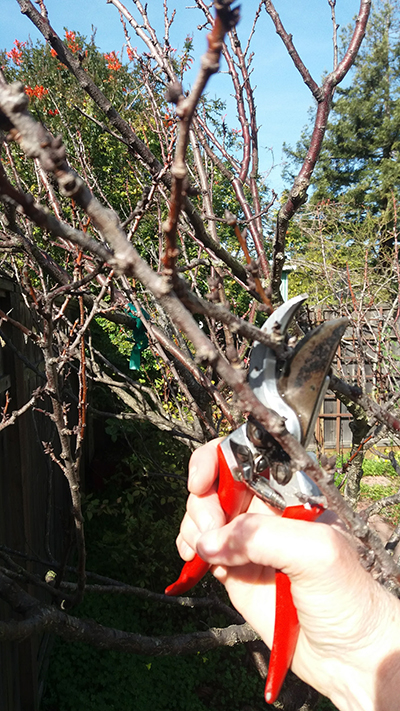by Alison Limoges, ABG Board member and Master Gardener
 Your beloved tree is too tall, too dense, too wide, or too misshapen so you want/need to prune it. Here are some basic dos, don’ts and rules to follow when pruning your tree or shrub.
Your beloved tree is too tall, too dense, too wide, or too misshapen so you want/need to prune it. Here are some basic dos, don’ts and rules to follow when pruning your tree or shrub.
First and foremost, wait until the tree is dormant—in late winter or early spring–after most of the leaves have dropped and before new growth starts and new buds appear. Pruning in the fall will tax the strength of the tree by encouraging new growth just as it’s heading into winter and its dormant season. Don’t prune just after a rain either, as the water may collect in the open cuts causing bacteria or disease to grow. There are a few exceptions to the above rule, though. Because they are susceptible to the devastating fungal disease Eutypa dieback, apricot and cherry trees should only be pruned in July or August, when rain is least expected. Another exception is citrus trees, which bear fruit year-round and may be pruned a little at any time of year.
Do use proper tools— bypass shears for small branches and loppers, small saws, or pole pruners for bigger branches. You’ll also need sturdy gloves, long sleeves and a ladder if necessary. Do clean the blades of your tools–with rubbing alcohol or diluted bleach (1 part bleach to 9 parts water) to prevent spreading plant diseases. Routinely carefully sharpen, oil and dry your tools.
For all trees, first look for and cut off the 3 Ds: Dead, Diseased, and Damaged branches. Also look for branches that are touching or crossing each other and cut off the smaller one. Also remove branches that are growing straight up or straight down and any suckers or water sprouts growing off the lower trunk of the tree. Remove all of your cuttings and all dead or diseased leaves from under the tree and place them in your green bin. Never prune more than 1/3 of a tree or shrub at any given time.
For younger trees you can prune and cull for height and for fruit density in the spring or summer —to keep the tree height manageable for easier picking and the size and amount of the fruit consistent from year to year. See Marla Koss’ fruit culling article in the Alameda Sun.
Why should we prune fruit and other trees?
- To strengthen the tree and improve fruit spacing and production.
- To remove dead, non-producing branches.
- To improve air circulation.
- To let in sunlight and promote photosynthesis.
- To provide a manageable harvesting height and density and an attractive shape.
When you are pruning:
Cut off branches just above the “collar” which is the thick ring around the branch close to the tree’s trunk. Cut the branches off cleanly and at a 45 degree angle so that water will run off the end of the branch. Always cut above outward facing buds so that new branches will grow out, not in towards the tree trunk. Most tree branches should grow at a 45 to 50 degree angle from the tree trunk, for best strength. There’s no need to cover the cuts with sap or paint. They heal better left uncovered. And be sure to research the kind of tree you’re pruning to see if it has special needs.
Excellent Resource: http://homeorchard.ucanr.edu/The_Big_Picture/Pruning_&_Training/
